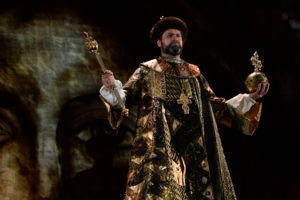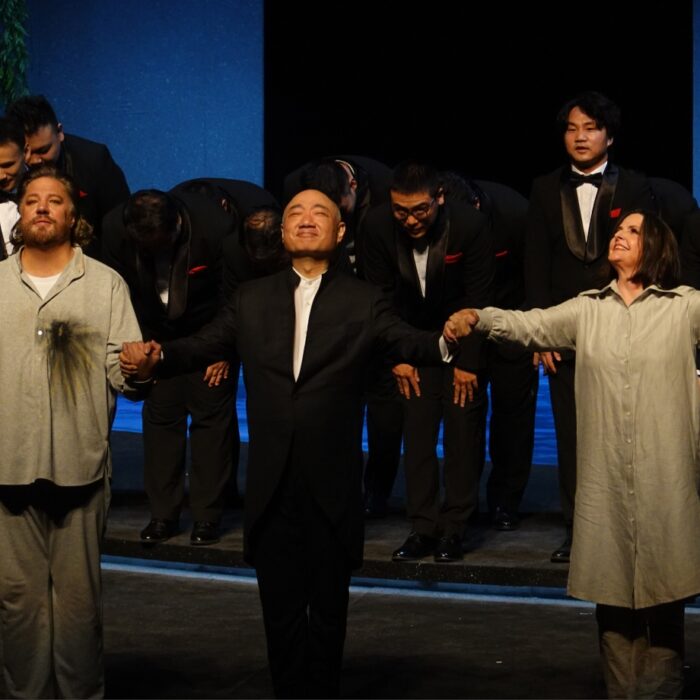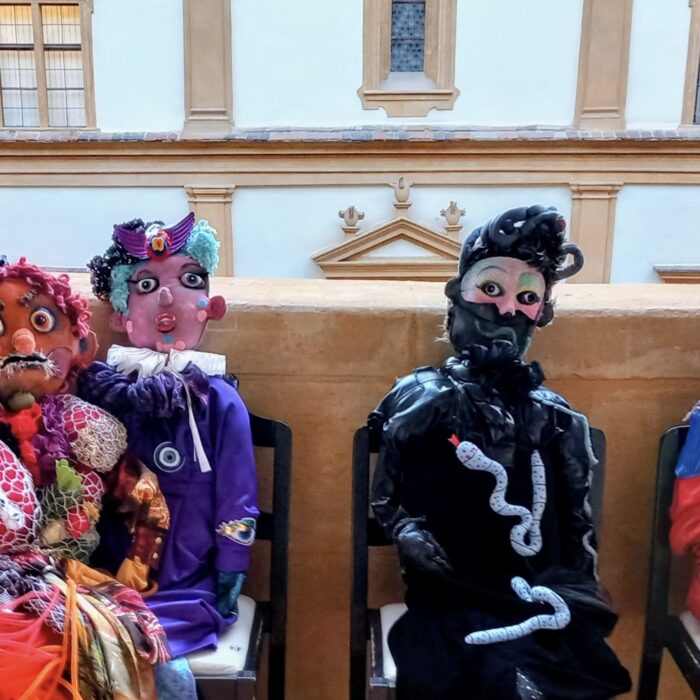
Opéra de Monte-Carlo 2020-21 Review: Boris Godunov
Ildar Abdrazakov Delivers Star Turn in 1869 Version of Mussorgsky’s Masterpiece
By Robert Adelson & Jacqueline LetzterTo close their 2020-2021 season, the Opéra de Monte-Carlo has presented a new production of Mussorgsky’s “Boris Godunov,” mounted in collaboration with Opéra Grand Avignon.
Monaco has long resounded with the strains of this opera, in part because of the prominent Russian presence on the Côte d’Azur from Mussorgsky’s time to today. Most notably, the work was performed at the Opéra de Monte-Carlo by the legendary interpreter of the title role, Russian bass Feodor Chaliapin (1873-1938), whose very last public performance was in 1937 at the Opéra de Monte-Carlo.
Any opera house that programs “Boris Godunov” is first confronted by the choice of which of the numerous—and strikingly different—versions to perform. Mussorgsky completed his score in 1869 but the committee of the Imperial Theatres of Russian Empire rejected the opera on the grounds that it had neither a significant female role, nor ballet numbers. Mussorgsky then set about revising his work, and it was this expanded and more refined version that was heard at the opera’s first performance in 1874. At the beginning of the twentieth century most performances of “Boris Godunov” used one of the revisions and reorchestrations made by Rimsky-Korsakov, either one dating from 1896 or another from 1906/1907. No fewer than six other versions would follow, including a reorchestration by Shostakovich in 1939/1940.
For the new Monte-Carlo production, stage director Jean-Romain Vesperini chose Mussorgsky’s rougher and shorter initial version from 1869, which curiously was never performed in the composer’s lifetime, only performed for the first time in 1928. These days, however, this version is becoming more and more popular: it was, for example, the vehicle for Bryn Terfel’s debut in the role of Boris at the Royal Opera House in 2016.
Unlike the sprawling 1874 version in prologue and four acts, the 1869 version is composed of seven tableaux, performed without intermission. The libretto hews closely to Pushkin’s original tragedy, tracing the core of the action from Boris’ coronation to his death. The continuous spectacle makes for an intense experience, akin to hearing Strauss’ “Salomé”, and is useful for today’s pandemic precautions as it avoids the inevitable socializing between acts.
Vesperini’s vision of the opera is rich in symbolism, set in an unspecified past and dominated by a huge all-seeing eye of Christ in the background, intended to remind us of Boris’ tormented conscience. The stage is divided into two levels, ostensibly for symbolic purposes: the upper level is reserved for the ruling class, while the lower level is mostly inhabited by the Russian people. In practice, the symbolism quickly lost its relevance, but the bi-level staging allowed for a better filling out of the space on the rather small stage, especially for choral scenes such as Boris’ coronation.
Exceptional Singing
The bass Ildar Abdrazakov was an imposing and moving Boris, plagued by guilt for the murder of the young tsarevich Dmitry. His mellifluous tone shifted with ease into the higher passages, with an elegant tapering of phrases. He easily projected above the orchestra, even in the final scene, sung almost entirely lying on his back.
The role of the chronicler-monk Pimen was sung by Alexeï Tikhomirov. He had such a commanding and interesting voice that one hung on his every word in his recollections of the court of Ivan the Terrible. Oleg Balachov gave a gripping interpretation of Grigorij/the Pretender, combining fine acting with an almost Heldentenor intensity. The role of Prince Shuisky was sung by Aleksandr Kravets, whose silvery timbre perfectly reflected the character of a wily intriguer.
Kiril Belov gave an emotional performance as the Holy Fool, whose plaintive lines haunted Boris in the confrontation outside St Basil’s Cathedral. His intentional and subtle lack of rhythmic coordination with the orchestra conveyed an additional impression of weariness.
The success of the performance was also in large part due to the fine conducting of Konstantin Chudovsky and the splendid contributions of the musicians of the Orchestre Philharmonique de Monte-Carlo. From the opening bassoon solo, the dark-hued sonorities of the orchestra created a rich tonal sphere for the singers to explore. The opening of the third tableau, with the serpentine viola lines and soft octaves in the clarinets beautifully set up Pimen’s first scene. The four-note motif that recurs throughout the opera was given a special accent on the upper dissonant note, creating a powerful sobbing effect. Chudovsky was also able to achieve forceful bell-like chords in the low brass, symbolizing the final death knells.
The administration of the Opéra Monte-Carlo is undoubtedly relieved to have this difficult season behind them. They succeeded in maintaining a high level of performance throughout a time when most other theatres around the world were silenced by the pandemic. Stay tuned for the company’s announcement next month of their plans for the coming season, which will be the last under the direction of Jean-Louis Grinda, before turning over the reins to his successor, Cecilia Bartoli.



